This is an AI Free Zone! Text created by ChatGPT and other Large Language Models is spreading rapidly across the Internet. It's well-written, artificial, frequently inaccurate. If you find a mistake on Spaceweather.com, rest assured it was made by a real human being. | | |
THE DANGER HAS NOT PASSED: Yesterday's severe geomagnetic storm is over, but the calm might not last. Giant shape-shifting sunspot AR3615 poses a continued threat for Earth-directed solar flares. NOAA forecasters say there is a 25% chance of X-flares today, tomorrow, and Wednesday. If the sunspot blows, it would give sky watchers in Europe and the USA a second chance at auroras this week. Solar flare alerts: SMS Text
SEVERE GEOMAGNETIC STORM--THE STRONGEST IN YEARS: As predicted, a CME struck Earth's magnetic field on March 24th (1437 UT). The impact opened a crack in our planet's magnetosphere and sparked a severe G4-class geomagnetic storm--the strongest geomagnetic storm since Sept. 2017.
The timing of the CME did *not* favor observers in Europe or the United States. Instead, New Zealand got the light show:
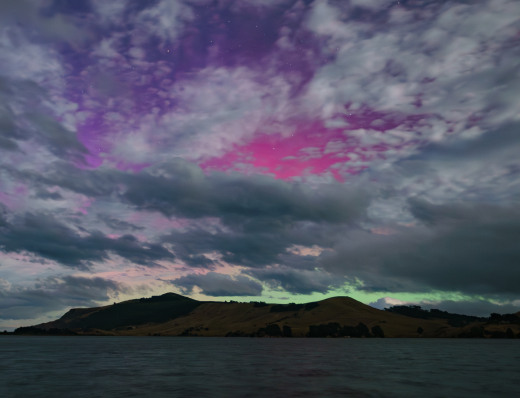
"I woke up early and, when I saw that a storm was underway, jumped out of bed and raced to my favourite viewing spot at Hoopers Inlet (latitude +46 S)," says photographer Ian Griffin. "The beautiful aurora australis was easily visible despite clouds and bright moonlight."
In England, it was broad daylight when the CME struck. Auroras could not be seen. Nevertheless, Stuart Green of Preston, England detected the storm using his backyard magnetometer:
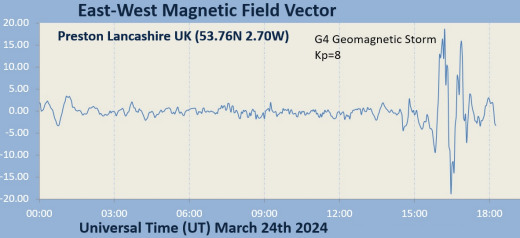
"My magnetometer kicked into life mid-afternoon here in the UK," says Green. "The arrival of the CME created a severe disturbance."
The squiggles in Green's chart represent changes in ground-level magnetic fields caused by the CME. "The sensor is buried in my garden about 0.5 meters below the surface in an East/West orientation," he explains. "This allows very sensitive (sub nanotesla) measurements of magnetic declination during geomagnetic storms."
Green built his own magnetometer from scratch. Would you like to do the same? Here's how.
Realtime Space Weather Photo Gallery
Free: Spaceweather.com Newsletter
18K GOLD "LOVE YOU TO THE MOON" LOCKET: This is a very special locket. It's heart-shaped, plated with 18K gold, and we will fly it again during this year's total eclipse of the sun. Keep reading...
On Jan. 26, 2024, the students of Earth to Sky Calculus launched this locket to the stratosphere onboard a cosmic ray research balloon. At the apex of the flight, it floated 111,535 feet above the Sierra Nevada mountains of central California:
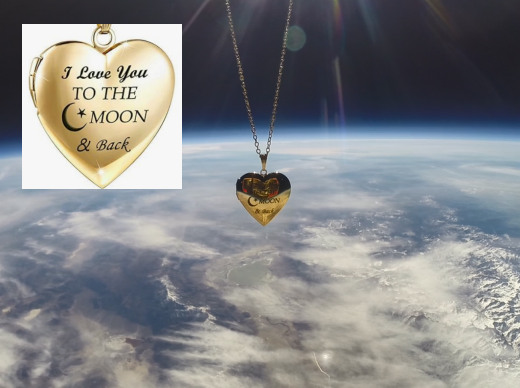
Buy it now for $149.95, and we'll fly it again--FOR FREE--during the total solar eclipse on April 8, 2024. The students will be launching multiple balloons from the path of totality in Texas. Your pendant will go along for the ride, touching the shadow of the Moon at the edge of space. (Simply type "FLY IT AGAIN" in the comments box at checkout.)
The locket, which opens to hold a personal photo or other small item, comes with a greeting card showing the jewelry in flight and telling the story of its journey to the edge of space.
Far Out Gifts: Earth to Sky Store
All sales support hands-on STEM education
Realtime Aurora Photo Gallery
Free: Spaceweather.com Newsletter
Realtime Comet Photo Gallery
Free: Spaceweather.com Newsletter
Every night, a network of
NASA all-sky cameras scans the skies above the United States for meteoritic fireballs. Automated software maintained by NASA's Meteoroid Environment Office calculates their orbits, velocity, penetration depth in Earth's atmosphere and many other characteristics. Daily results are presented here on Spaceweather.com.
On Mar 24, 2024, the network reported 1 fireball.
(1 sporadic)
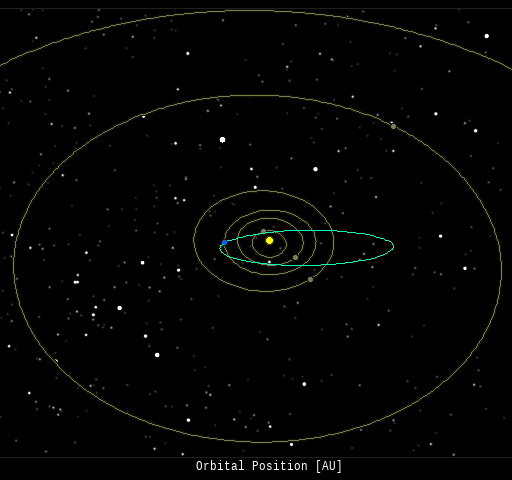
In this diagram of the inner solar system, all of the fireball orbits intersect at a single point--Earth. The orbits are color-coded by velocity, from slow (red) to fast (blue). [Larger image] [movies]
Potentially Hazardous Asteroids (
PHAs) are space rocks larger than approximately 100m that can come closer to Earth than 0.05 AU. None of the known PHAs is on a collision course with our planet, although astronomers are finding
new ones all the time.
On March 25, 2024 there were 2349 potentially hazardous asteroids.
 |
Recent & Upcoming Earth-asteroid encounters: | Asteroid | Date(UT) | Miss Distance | Velocity (km/s) | Diameter (m) |
| 2024 FO1 | 2024-Mar-20 | 6 LD | 14.8 | 17 |
| 2024 EQ3 | 2024-Mar-20 | 12 LD | 10.8 | 14 |
| 2024 EZ3 | 2024-Mar-20 | 11.6 LD | 5.8 | 25 |
| 2024 EY3 | 2024-Mar-20 | 12 LD | 11.6 | 44 |
| 2024 FD1 | 2024-Mar-20 | 2.9 LD | 5.1 | 5 |
| 2024 FN2 | 2024-Mar-21 | 9.9 LD | 6.9 | 25 |
| 2024 FK1 | 2024-Mar-22 | 2.7 LD | 7.5 | 21 |
| 2024 EU4 | 2024-Mar-23 | 18.9 LD | 28.3 | 134 |
| 2024 EL4 | 2024-Mar-23 | 14.7 LD | 11.8 | 39 |
| 2024 EC4 | 2024-Mar-24 | 19.5 LD | 4 | 26 |
| 2019 CJ | 2024-Mar-24 | 12.4 LD | 4.4 | 28 |
| 2021 CF6 | 2024-Mar-25 | 14.6 LD | 8.3 | 62 |
| 2024 EA3 | 2024-Mar-27 | 8.2 LD | 10.8 | 47 |
| 2024 EO4 | 2024-Mar-27 | 13.1 LD | 14.9 | 40 |
| 2024 EO3 | 2024-Mar-28 | 10.1 LD | 11.4 | 40 |
| 2024 FN1 | 2024-Mar-28 | 16 LD | 6.6 | 21 |
| 2024 ES4 | 2024-Mar-28 | 17.8 LD | 5.1 | 25 |
| 2024 FB1 | 2024-Mar-29 | 7.6 LD | 13.2 | 31 |
| 2024 FK | 2024-Mar-29 | 3.1 LD | 19.2 | 30 |
| 2024 ED4 | 2024-Mar-29 | 14.5 LD | 7.8 | 19 |
| 2023 RO49 | 2024-Mar-29 | 14.1 LD | 4.3 | 45 |
| 2015 MB54 | 2024-Mar-30 | 11.7 LD | 3.8 | 54 |
| 2024 DQ | 2024-Mar-30 | 6.4 LD | 2.9 | 41 |
| 2018 CC14 | 2024-Apr-03 | 19.6 LD | 8.9 | 115 |
| 2023 GC2 | 2024-Apr-04 | 8.7 LD | 5.7 | 12 |
| 2024 FG | 2024-Apr-07 | 12.4 LD | 9.8 | 53 |
| 2024 FH2 | 2024-Apr-07 | 16.2 LD | 19.8 | 129 |
| 2005 FG | 2024-Apr-08 | 18.4 LD | 5.5 | 57 |
| 2020 BP13 | 2024-Apr-09 | 15.2 LD | 6.8 | 209 |
| 2021 RJ19 | 2024-Apr-12 | 19.6 LD | 11.4 | 25 |
| 2021 GQ5 | 2024-Apr-13 | 8.8 LD | 7.5 | 7 |
| 2023 FN13 | 2024-Apr-14 | 3.3 LD | 4.9 | 13 |
| 2022 UO1 | 2024-Apr-14 | 16.7 LD | 14 | 33 |
| 517681 | 2024-Apr-15 | 18.4 LD | 14.2 | 589 |
| 439437 | 2024-Apr-15 | 8.5 LD | 16.5 | 609 |
| 2023 HU3 | 2024-Apr-18 | 15.9 LD | 19.1 | 35 |
| 2021 JW2 | 2024-Apr-19 | 1.6 LD | 5.1 | 11 |
| 2017 SA20 | 2024-Apr-19 | 3.8 LD | 6.2 | 8 |
| 2021 VH2 | 2024-Apr-25 | 9.3 LD | 2.7 | 6 |
| 2021 GD3 | 2024-Apr-30 | 11.4 LD | 3.5 | 14 |
| 2022 TN1 | 2024-Apr-30 | 18.6 LD | 17.7 | 295 |
| 2022 AA5 | 2024-May-02 | 12 LD | 8.9 | 67 |
| 2021 JG9 | 2024-May-10 | 16.9 LD | 16.1 | 32 |
| 2016 FT14 | 2024-May-10 | 19.9 LD | 5.9 | 39 |
| 2015 KJ19 | 2024-May-14 | 15.8 LD | 23.1 | 112 |
| 2014 WF6 | 2024-May-14 | 7.2 LD | 18.9 | 47 |
| 2021 JN10 | 2024-May-14 | 17.5 LD | 13.2 | 33 |
| 2021 JJ | 2024-May-15 | 17.2 LD | 5.8 | 28 |
| 2022 WN2 | 2024-May-17 | 13.7 LD | 5.5 | 6 |
| 2019 VB5 | 2024-May-21 | 7.8 LD | 6.3 | 2 |
Notes: LD means "Lunar Distance." 1 LD = 384,401 km, the distance between Earth and the Moon. 1 LD also equals 0.00256 AU. | | Cosmic Rays in the Atmosphere |
SPACE WEATHER BALLOON DATA: Almost once a week, Spaceweather.com and the students of Earth to Sky Calculus fly space weather balloons to the stratosphere over California. These balloons are equipped with sensors that detect secondary cosmic rays, a form of radiation from space that can penetrate all the way down to Earth's surface. Our monitoring program has been underway without interruption for 7 years, resulting in a unique dataset of in situ atmospheric measurements.
Latest results (July 2022): Atmospheric radiation is decreasing in 2022. Our latest measurements in July 2022 registered a 6-year low:
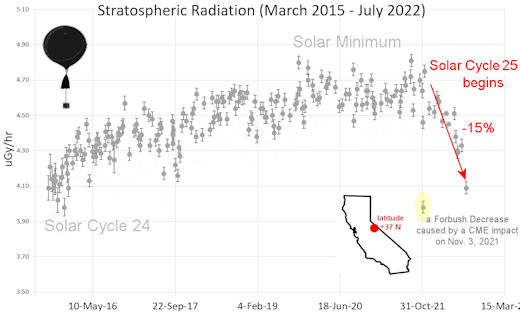
What's going on? Ironically, the radiation drop is caused by increasing solar activity. Solar Cycle 25 has roared to life faster than forecasters expected. The sun's strengthening and increasingly tangled magnetic field repels cosmic rays from deep space. In addition, solar coronal mass ejections (CMEs) sweep aside cosmic rays, causing sharp reductions called "Forbush Decreases." The two effects blend together to bring daily radiation levels down.
.Who cares? Cosmic rays are a surprisingly "down to Earth" form of space weather. They can alter the chemistry of the atmosphere, trigger lightning, and penetrate commercial airplanes. According to a study from the Harvard T.H. Chan school of public health, crews of aircraft have higher rates of cancer than the general population. The researchers listed cosmic rays, irregular sleep habits, and chemical contaminants as leading risk factors. A number of controversial studies (#1, #2, #3, #4) go even further, linking cosmic rays with cardiac arrhythmias and sudden cardiac death.
Technical notes: The radiation sensors onboard our helium balloons detect X-rays and gamma-rays in the energy range 10 keV to 20 MeV. These energies span the range of medical X-ray machines and airport security scanners.
Data points in the graph labeled "Stratospheric Radiation" correspond to the peak of the Regener-Pfotzer maximum, which lies about 67,000 feet above central California. When cosmic rays crash into Earth's atmosphere, they produce a spray of secondary particles that is most intense at the entrance to the stratosphere. Physicists Eric Regener and Georg Pfotzer discovered the maximum using balloons in the 1930s and it is what we are measuring today.
| | The official U.S. government space weather bureau |
| | The first place to look for information about sundogs, pillars, rainbows and related phenomena. |
| | Researchers call it a "Hubble for the sun." SDO is the most advanced solar observatory ever. |
| | 3D views of the sun from NASA's Solar and Terrestrial Relations Observatory |
| | Realtime and archival images of the Sun from SOHO. |
| | information about sunspots based on the latest NOAA/USAF Active Region Summary |
| | current counts of failed and deployed Starlink satellites from Jonathan's Space Page |
| | Authoritative predictions of space junk and satellite re-entries |
| | from the NOAA Space Environment Center |
| | fun to read, but should be taken with a grain of salt! Forecasts looking ahead more than a few days are often wrong. |
| | from the NOAA Space Environment Center |
| | the underlying science of space weather |
 | When looking for casinos to play online when the weather is bad, you can try the SkyCity Online Casino if you are located in New Zealand. If you are not from NZ you can try the Swedish page Svenska casino online to find suitable games, check out svenskacasinoonline.net. Always check your local laws before playing with real money.. |
 | BestCSGOGambling is the best site for everything related to CSGO gambling on the web |
| | These links help Spaceweather.com stay online. Thank you to our supporters! |
| | | | | | |

